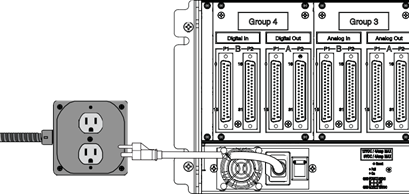Documentation Home Page ◇ Hardware Home Page
Pour la documentation en FRANÇAIS, utilisez l'outil de traduction de votre navigateur Chrome, Edge ou Safari. Voir un exemple.
OP5607 Installation and Configuration
Installation is simply a matter of placing the chassis on a shelf or a desktop or inserting it into a traditional rack and connecting the cables. When installing an OP5607 in a system, it is important to have all connections completed before turning the unit on.
Connecting Cables
These are the basic cabling instructions for your OP5607. Use the cables provided to connect your devices, as instructed.
Step 1
| PCIe connection for OP5607-IO-PCIe units only | If your OP5607 came as part of full system delivery, including an OPAL-RT simulator, simply connect the PCIe cable between the simulator and the OP5607 PCIe connector in the back of the unit. Make sure to connect the cable end labeled host to the simulator, and the cable end labeled target to the OP5607. If you purchased the OP5607 as a separate unit, it is delivered with a PCIe cable and a PCIe interface board. This board must be installed in your OPAL-RT simulator. Contact OPAL-RT Support for instructions to install the PCIe adaptor board in the simulator. Then connect the PCIe cable from the PCIe connector at the back of the OP5607 to the simulator. Make sure to connect the cable end labeled host to the simulator, and the cable end-labeled target to the OP5607. |
|---|---|
| SFP connection - for OP5607-IO-MUSE units only | If your OP5607 came configured for MuSE communication, use the SFP transceivers and LC-LC multimode fiber cable purchased with the unit to connect one of the unit’s SFP ports to one of the real-time simulator’s SFP ports configured for MuSE communication. Unless otherwise specified in the System Description document of your unit, any of the sixteen SFP ports can be used for MuSE communication. When using SFP ports for Generic Aurora communication with other OPAL-RT units or external devices, additional SFP modules and optical fiber cable are required. |
Step 2
Connect the power cord to the unit and plug it into an appropriate power source (outlet).
Step 3
Connect the DB37 cables from the OP5607 to external devices (motor, controller, etc.). Before connecting cables, make sure that the amplitude is compatible with the voltage ranges of the OP5300 mezzanine modules installed.
Step 4
If you use a PCIe connection, power up the OP5607 before you power up the simulator. Failure to do so will prevent the simulator from detecting the OP5607 FGPA during boot.
If you use an SFP connection in a MuSE setup, powering up the OP5607 before the simulator is not mandatory, but it must be powered up before loading the real-time simulation.
Testing I/O Signals
Before using your OP5607, we recommend running the RT-LAB or HYPERSIM integration model delivered with your system. If the I/O configuration is symmetrical (same type and the number of inputs and outputs), it is good practice to test I/O channels using the loopback board provided with the integration kit, which lets you read any feedback from outputs to inputs.
Connecting the I/O Loopback Kit
Note: The following procedure is only used for test purposes when no external source is available.
The loopback kit included in the starter kit allows users to test system signals. The connection is made easy with a custom flat cable that matches OPAL-RT standard DB37 pin assignments.
- Connect one end of the flat cable to the loopback board
- Connect the loopback board to the simulator DB37 Output signal
- Connect the other end (DB37 connector) of the flat cable to the simulator DB37 Input signal
- Connect the VUser* (required to preserve isolation) from the loopback board to the OP5700
* For more information about the use of Vuser and Vrtn pleaser refer to this article in the OPAL-RT knowledge base : How to power the different DB37 boards for digital outputs.
Note: Although some boards do provide a power source, using that would compromise the isolation. OPAL-RT recommends using external power source: the user must connect the power wires (provided) to either a 5 or 12 V power source. Make sure that the Vuser source switch on the loopback board is set to “External”.
The breakout board provided allows users to access each pin of the DB37 separately through the screw terminals. Simply insert the breakout board DB37 connector onto the desired DB37 connector on the simulator.
Refer to the system description document or the user manual of the OP5300 Mezzanine Modules installed in the system for exact pin assignments.
OPAL-RT TECHNOLOGIES, Inc. | 1751, rue Richardson, bureau 1060 | Montréal, Québec Canada H3K 1G6 | opal-rt.com | +1 514-935-2323
Follow OPAL-RT: LinkedIn | Facebook | YouTube | X/Twitter



